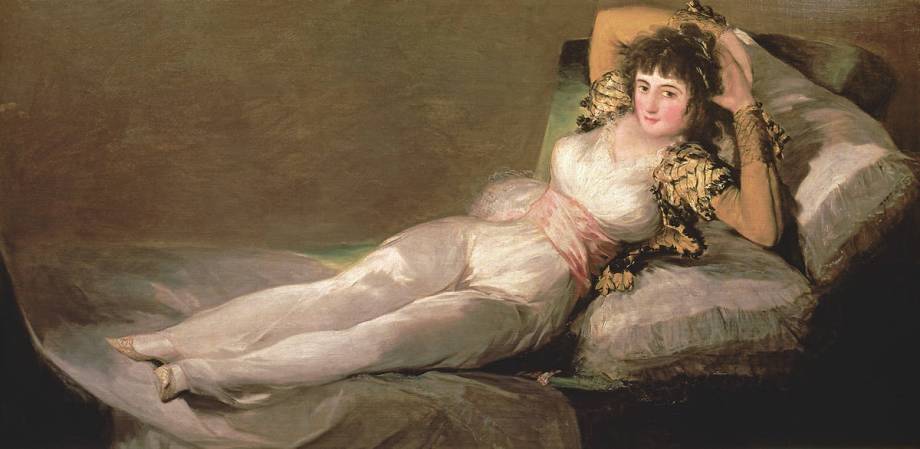Shop art print and framed art The Clothed Maja by Francisco de Goya
Customise
Your art print
The Clothed Maja OF Francisco de Goya

The Clothed Maja
Goya's Maja vêtue: A painting commissioned in the shadows
Francisco de Goya produced The Clothed Maja around 1800, during a pivotal period when he was moving away from religious scenes to take a greater interest in everyday life and secular subjects. The Clothed Maja is thought to have been commissioned by Manuel Godoy, an influential politician of the time and art collector. This work is often presented in parallel with La Maja nue, produced around 1797-1800, which depicts the same subject but without clothes. Goya is said to have produced this clothed version to avoid the wrath of the Inquisition.
In this 95 × 188 cm painting on display at the Museo del Prado in Madrid, the identity of the woman depicted, lying languidly on a silk bed, remains a mystery. Some believe it to be the Spanish prime minister's mistress, Pepita Tudó, while others believe it could be an anonymous representation of women during the Spanish Enlightenment.
La Maja vêtue: A bold and sensual composition
The painting depicts a woman reclining nonchalantly on a sofa. Her pose is confident, almost provocative, with her arms folded behind her head and her gaze fixed on the viewer. She is wearing a light-coloured dress that hints at the shape of her body, while the bright yellow of her jacket contrasts with the painting's dark, neutral background. The silk sheets and cushions emphasise the beauty and sensuality of the young woman, highlighted by the light coming from the left.
The colours chosen by Goya are soft and harmonious, mixing warm and cool tones to sublimate his muse, while contrasting with the darker, more provocative character of La Maja nue. The composition is simple but effective, centred on the figure of the maja who occupies most of the pictorial space.
The Maja: A modern, free woman
The central subject of the painting is this young woman, the maja, a symbol of popular beauty and freedom. Her direct gaze and casual attitude testify to a self-assurance and independence of spirit uncommon for the period. She embodied a certain modernity, breaking with social conventions and the classical canons of beauty. Goya depicted her with great sensuality, emphasising the curves of her body and the delicacy of her features. The maja is both seductive and enigmatic, arousing desire and admiration.
Symbolism of The Dressed Maja: Between tradition and transgression
La Maja vêtue is rich in symbolism. The Maja's costume, although traditional, is worn here in a provocative manner, accentuating the model's sensuality. The jewels, flowers and precious fabrics evoke wealth and luxury, but also vanity and transience. The divan, a symbol of comfort and voluptuousness, can also be interpreted as a place of temptation and sin. The maja's direct gaze, challenging the viewer, can be seen as an affirmation of her freedom and power of seduction. The painting thus plays on ambiguity, between tradition and transgression, beauty and danger, attraction and repulsion.
Role of La Maja vêtue in Goya's artistic career
Francisco de Goya is often described as a forerunner of the Romantic movement, due to his tendency to depart from the strict conventions of academic painting. Although he trained in the studio of José Luzán, he quickly developed his own style characterised in particular by its vivid colours and sharp contrasts.
With La Maja vêtue and its nude counterpart La Maja nue, Goya explored new techniques for depicting female beauty without falling into the usual clichés. He seems to be searching for a raw truth, far removed from the artistic ideals of the time, which lends his works a captivating dramatic intensity.
La Maja Habillée: a critical look at Spanish society at the time
Although the main subject of La Maja vêtue may appear to be simply intended to flatter the male sensibility, this painting and its nude version can be seen as a subtle testimony to the social reality of the time. The depiction of a woman revealing her body in this bold and sensual way, symbolising a form of rebellion against the rigid moral values imposed by the Church, was not common in 18th-century Spanish artistic production.
Goya thus inscribed in these works the desire for cultural renewal characteristic of the Spanish Enlightenment, characterised by a questioning of social norms and a quest for emancipation for the individual.
The posterity of Francisco Goya's La Maja vêtue
The influence of La Maja habillée on artistic posterity is undeniable. Many painters of the Romantic and Impressionist movements were inspired by this work to express their own visions of the female body, including Édouard Manet with his famous Olympia, which features the provocative pose and direct gaze of the maja. Goya's stylistic daring opened up a new path in the representation of women, helping to enrich an artistic debate that continues to this day.
This artwork is a painting from the classical period. It belongs to the romanticism style.
« The Clothed Maja » is kept at Prado, Madrid, Spain.
Find the full description of The Clothed Maja by Francisco de Goya on Wikipedia.
- 30% !
Make good deals by browsing our Reserve : editions of our catalog which await their purchaser at a low price.













